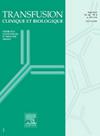重症监护病房患者输血后主动监测急性输血反应的发生率及危险因素。
IF 1.2
4区 医学
Q4 HEMATOLOGY
引用次数: 0
摘要
背景和目的:由于潜在疾病或某些预用药,危重患者的输血反应常常被掩盖。该研究计划通过积极监测输血事件,了解重症监护(ICU)患者急性输血反应(ATRs)的发生率,并确定与这些反应相关的危险因素。材料和方法:在这项前瞻性观察性研究中,纳入了输血前入住ICU并在ICU住院24小时的危重患者。每位入组患者在每次输血后15分钟、1小时、6小时和24小时进行积极监测。研究期间从ICU报告的输血反应被认为是被动报告的atr。结果:850个成分的输血转化为430次输血事件被积极监测。27例患者出现33例atr。主动监测组ATR发生率(0.039)高于被动报告组(0.006)。主动监测中,共记录到TACO 6例,TAD 2例,TRALI和TTBI各1例,FNHTR 3例。在TACO组中观察到正体液平衡(p=0.01)与全身性水肿(p=0.01)之间的显著关联。12例被标记为无法分类的输血并发症。血压升高是所有病例中观察到的唯一症状。输血后1小时、6小时、24小时的平均收缩压、舒张压均显著高于输血前(p < 0.05)。结论:主动监测为我们提供了对各种atr发生率的真实洞察。本文章由计算机程序翻译,如有差异,请以英文原文为准。
Incidence and risk factors of acute transfusion reactions in patients admitted in intensive care unit on active monitoring after transfusion
Background and objectives
Transfusion reaction is often masked in critically ill patients because of underlying disease or certain pre-medications. The study was planned to know the incidence and determine risk factors associated with these acute transfusion reactions (ATRs) in intensive care (ICU) patients by actively monitoring the transfusion events.
Material and methods
In this prospective observational study, critically ill patients admitted to ICU and having an ICU stay of 24 h prior to transfusion were enrolled. Each enrolled patient was actively monitored after each transfusion of blood component at 15 min, 1 h, 6 h and 24 h. Transfusion reactions reported from ICU during the study period were considered as passively reported ATRs.
Results
Transfusion of 850 components translating to 430 transfusion episodes was actively monitored. Thirty-three ATRs were observed in 27 patients. Incidence of ATR on active monitoring (0.039) was higher than on passive reporting (0.006). On active monitoring, 06 cases of TACO, 2 cases of TAD, 1 case each of TRALI and TTBI, 3 cases of FNHTR were recorded. A significant association between positive fluid balance (p = 0.01) and generalised oedema (p = 0.01) was observed with TACO. Twelve cases were labelled as unclassifiable complication of transfusion. Rise in BP was the only symptom observed in all these cases. The mean post-transfusion systolic blood pressure and diastolic blood pressure at 1 h, 6 h and 24 h were significantly higher (p < 0.05) than pre-transfusion values.
Conclusion
Active monitoring provides us with a true insight into the incidence of various ATRs.
求助全文
通过发布文献求助,成功后即可免费获取论文全文。
去求助
来源期刊
CiteScore
2.50
自引率
11.80%
发文量
234
审稿时长
36 days
期刊介绍:
Transfusion Clinique et Biologique, the official journal of the French Society of Blood Transfusion (SFTS):
- an aid to training, at a European level
- the only French journal indexed in the hematology and immunology sections of Current Contents
Transfusion Clinique et Biologique spans fundamental research and everyday practice, with articles coming from both sides. Articles, reviews, case reports, letters to the editor and editorials are published in 4 editions a year, in French or in English, covering all scientific and medical aspects of transfusion: immunology, hematology, infectious diseases, genetics, molecular biology, etc. And finally, a convivial cross-disciplinary section on training and information offers practical updates.
Readership:
"Transfusers" are many and various: anesthetists, biologists, hematologists, and blood-bank, ICU and mobile emergency specialists...

 求助内容:
求助内容: 应助结果提醒方式:
应助结果提醒方式:


